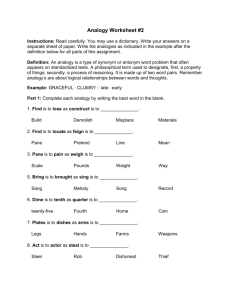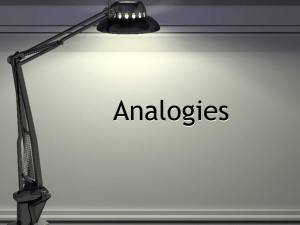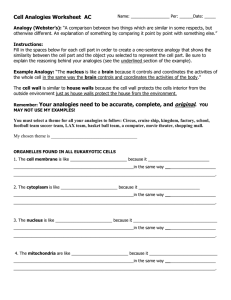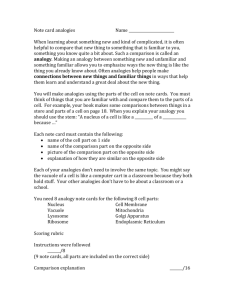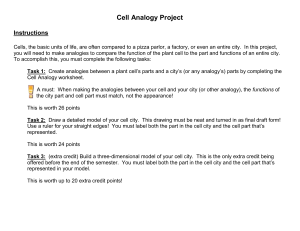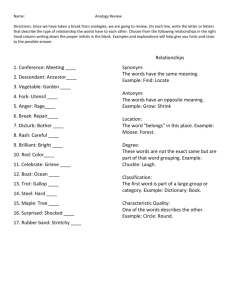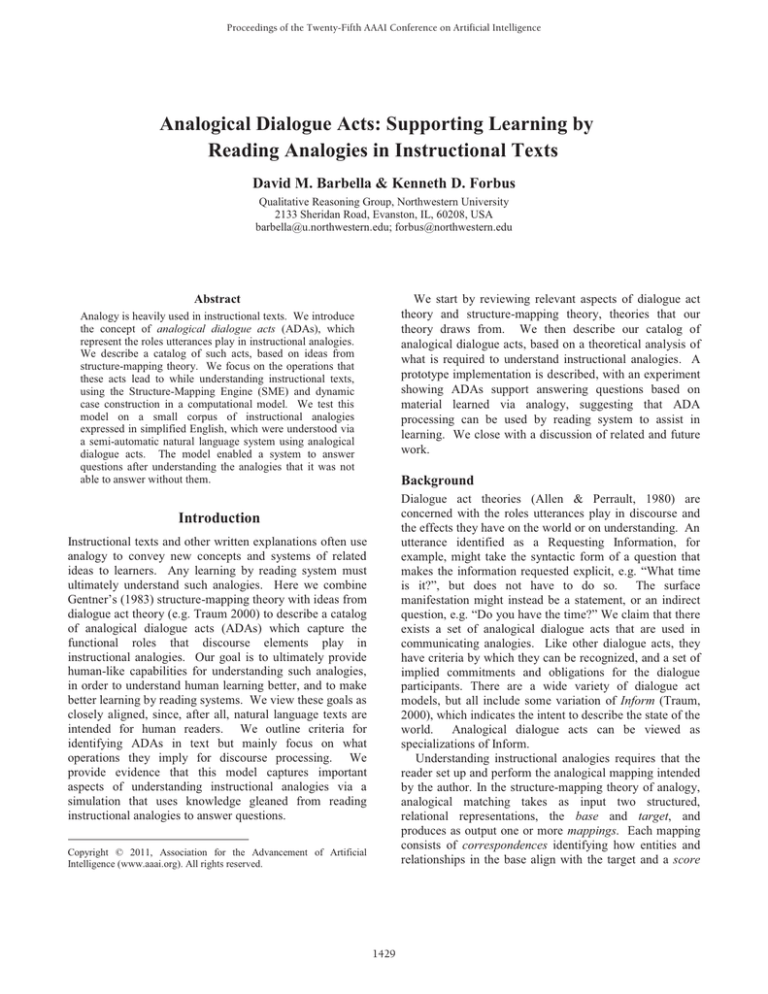
Proceedings of the Twenty-Fifth AAAI Conference on Artificial Intelligence
Analogical Dialogue Acts: Supporting Learning by
Reading Analogies in Instructional Texts
David M. Barbella & Kenneth D. Forbus
Qualitative Reasoning Group, Northwestern University
2133 Sheridan Road, Evanston, IL, 60208, USA
barbella@u.northwestern.edu; forbus@northwestern.edu
We start by reviewing relevant aspects of dialogue act
theory and structure-mapping theory, theories that our
theory draws from. We then describe our catalog of
analogical dialogue acts, based on a theoretical analysis of
what is required to understand instructional analogies. A
prototype implementation is described, with an experiment
showing ADAs support answering questions based on
material learned via analogy, suggesting that ADA
processing can be used by reading system to assist in
learning. We close with a discussion of related and future
work.
Abstract
Analogy is heavily used in instructional texts. We introduce
the concept of analogical dialogue acts (ADAs), which
represent the roles utterances play in instructional analogies.
We describe a catalog of such acts, based on ideas from
structure-mapping theory. We focus on the operations that
these acts lead to while understanding instructional texts,
using the Structure-Mapping Engine (SME) and dynamic
case construction in a computational model. We test this
model on a small corpus of instructional analogies
expressed in simplified English, which were understood via
a semi-automatic natural language system using analogical
dialogue acts. The model enabled a system to answer
questions after understanding the analogies that it was not
able to answer without them.
Background
Dialogue act theories (Allen & Perrault, 1980) are
concerned with the roles utterances play in discourse and
the effects they have on the world or on understanding. An
utterance identified as a Requesting Information, for
example, might take the syntactic form of a question that
makes the information requested explicit, e.g. “What time
is it?”, but does not have to do so. The surface
manifestation might instead be a statement, or an indirect
question, e.g. “Do you have the time?” We claim that there
exists a set of analogical dialogue acts that are used in
communicating analogies. Like other dialogue acts, they
have criteria by which they can be recognized, and a set of
implied commitments and obligations for the dialogue
participants. There are a wide variety of dialogue act
models, but all include some variation of Inform (Traum,
2000), which indicates the intent to describe the state of the
world. Analogical dialogue acts can be viewed as
specializations of Inform.
Understanding instructional analogies requires that the
reader set up and perform the analogical mapping intended
by the author. In the structure-mapping theory of analogy,
analogical matching takes as input two structured,
relational representations, the base and target, and
produces as output one or more mappings. Each mapping
consists of correspondences identifying how entities and
relationships in the base align with the target and a score
Introduction
Instructional texts and other written explanations often use
analogy to convey new concepts and systems of related
ideas to learners. Any learning by reading system must
ultimately understand such analogies. Here we combine
Gentner’s (1983) structure-mapping theory with ideas from
dialogue act theory (e.g. Traum 2000) to describe a catalog
of analogical dialogue acts (ADAs) which capture the
functional roles that discourse elements play in
instructional analogies. Our goal is to ultimately provide
human-like capabilities for understanding such analogies,
in order to understand human learning better, and to make
better learning by reading systems. We view these goals as
closely aligned, since, after all, natural language texts are
intended for human readers. We outline criteria for
identifying ADAs in text but mainly focus on what
operations they imply for discourse processing. We
provide evidence that this model captures important
aspects of understanding instructional analogies via a
simulation that uses knowledge gleaned from reading
instructional analogies to answer questions.
Copyright © 2011, Association for the Advancement of Artificial
Intelligence (www.aaai.org). All rights reserved.
1429
mapping and case construction interact with the properties
of discourse. To successfully work through an instructional
analogy, a reader must understand that analogy is being
employed and what goes into the base and what goes into
the target. Formulating the base and target can be complex
because what is stated in the text needs to be combined
with what the reader already knows. Often readers know
more than is relevant to a particular analogy, and there can
be multiple mappings between the base and the target.
Hence instructional analogies often walk readers through
the intended mapping and conclusions to be drawn from it.
Analogical dialogue acts identify these constraints, so that
they can be used in the reader’s understanding process.
Next we describe our proposed analog dialogue acts.
We focus here on analyzing what processing needs to be
done in response to such acts, laying out a space of
possibilities based on human observations and logical
possibility, with a specific set of processing choices
instantiated in a computer model. We also outline some
identification criteria, although that is not the focus of this
paper (see future work), based on informal analyses. The
first three acts are concerned with identifying the
representations to be compared, and the rest are concerned
with correspondences and candidate inferences.
Introduce Comparison: Identifies the base and target
to be compared. For example, in “We can understand
convection by comparing it to water leaking from a
bucket.” the base is a situation involving leaking water,
and the target is the phenomenon of convection. The
comparison is often not introduced first, e.g. in Figure 1
the target is described before the comparison introduction.
In Figure 1 the comparison is introduced explicitly in a
single sentence, but more complex cases involve
combining information across multiple sentences, e.g.
parallel sentence structure in subsequent sentences.
Determining which of the domains is the base and which is
the target requires a non-local assessment about what the
text is about. (This particular example is drawn from a
book on solar energy, and the rest of the chapter makes
clear that heat is the domain being taught.) Since
candidate inferences can be constructed bidirectionally, an
incorrect assessment is not fatal.
Processing an Introduce Comparison act requires
producing appropriate cases for the base and target. The
target is constrained by what has already been introduced
in the text. The base, unless it has been used before in the
same text and is being used in a consistent manner, must be
constructed from the reader’s knowledge. Whether this is
done aggressively or lazily is, we suspect, a strategy that is
subject to individual variation. Ambiguity in linguistic
cues can lead to the need to explore possible construals of
a case, to find combinations with significant overlap.
Extend Base, Extend Target: These acts add
information to the base or target of a comparison,
respectively. Such acts are identified by relationships
and/or entities being mentioned in the same statement as an
indicating the structural quality of the mapping. Mappings
also include candidate inferences, base statements that are
projected onto the target, or vice-versa, suggested by the
correspondences of the mapping. In discourse, candidate
inferences are often used to convey new information to the
learner, or to highlight differences.
The Structure-Mapping Engine (SME) provides a
simulation of analogical matching (Falkenhainer et al
1989; Forbus et al 1994; Forbus et al 2002). SME also
allows constraints on matches as input. Given a base item
bi and target item tj, either entities or statements,
required(bi tj) means that bi must correspond to tj in every
mapping, and excluded(bi tj) means that bi cannot
correspond to tj in any mapping.
In understanding instructional analogies, a learner is
expected to draw upon their existing world knowledge,
particularly about the base domain. In some situations,
whole cases representing a prior experience are retrieved
from memory. In other situations, cases seem to be
constructed dynamically from one’s general knowledge of
the world. We use dynamic case construction methods
A hot brick leaks heat to a cool room.
The temperature difference between the brick's
temperature and the room's temperature pushes the
heat from the brick.
The heat escapes until the temperature difference
disappears.
Extend Target
The hot brick is like a bucket of the water.
Introduce Comparison
There is a hole in the bucket. The water exits the
bucket through the hole. The water's depth exceeds
the hole's height. A volume of water flows from the
bucket. The depth difference between the water's
depth and the hole's height causes the flow. After the
water leaves, the depth difference disappears. When
the depth difference disappears, the volume does not
exit through the hole.
Extend Base
The temperature difference is like the depth
difference.
Introduce Correspondence
Figure 1: An analogy from our test corpus,
hand-annotated with analogical dialogue acts.
(Mostek et al 2000) to model this. In dynamic case
construction, a seed entity or concept is provided as a
starting point, and facts which mention it are gathered,
typically filtered by some criterion and then further
expanded. For example, “The economy of India” might
have India as its seed, and facts filtered based on their
relevance to economic matters.
Analogical Dialogue Acts
Our model of analogical dialog acts is based on an analysis
of how the functional constraints on performing analogical
1430
Source Text
Recognition
Rules
Translation*
QRG-CE Text
Semantic
Representation
EA NLU
Discourse
Interpretation
ADA
Hypotheses
Comprehension
Questions
Facts from
Memory
Build Base and
Target
Build Required
Correspondences
Required
Correspondences
Translation*
Queries
Dynamic Case
Construction
Cases
SME
Question
Answering
Answers
Candidate
Inferences
Figure 2: Architecture of the experimental prototype. Processes performed by hand are marked with an asterisk.
Introduce Candidate Inference: These acts alert the
reader to information that the author intended to convey
via the analogy. An example is “Just as water leaks faster
from a fuller bucket, heat leaks faster from a warmer
brick.” Phrases such as “just as” and “just like”, or even
“Like <base statement to be projected>, <resulting
candidate inference>.” are clues for identifying such acts.
If the candidate inference can be found in the mapping that
the reader has built up so far, then that surmise should be
given additional credence.
If the candidate inference
cannot be found, then there are several possibilities that a
reader should explore: Their construal of the base or target
might be too different from what the author expects, or
they should generate a different mapping.
Block Candidate Inference: These acts alert the reader
that an inference that they are likely to make is not in fact
correct. For example, “Unlike solar radiation, heat flow
that occurs by conduction is unaffected by color.” If the
candidate inference is part of the reader’s mapping, this act
indicates that the reader should ignore them. Aggressive
readers who did not generate this inference might explore
modifications of their base or target to see if they can
generate it, thereby ensuring they are more in sync with the
author’s intentions and thus better able to process
subsequent statements. These acts are sometimes
identifiable by terms such as “unlike,” “however,” or “you
might expect… but” which include one clause expressing
information about the base and one clause expressing
information about the target. In our experience these acts,
like Block Correspondence, occur relatively infrequently.
entity in the base or target, but which is not a statement
about correspondences or candidate inferences.
For
example, “There is a hole in the bucket.” extends the base,
and “A brick leaks heat to a cool room.” extends the target.
Entities mentioned in these acts are added to the construal
of the case by retrieving additional knowledge about them,
focusing on statements involving other entities in the
current construal. If the facts mentioned are not already
known to the reader, they are provisionally accepted as
being true about the base or target, as appropriate.
Introduce Correspondence: These acts provide clues
as to the author’s intended mapping. For example, “The
temperature difference is like the depth difference.”
indicates that those two entities correspond. Sometimes
Introduce Correspondence acts are expressed as identity
statements, e.g. “The glass is the atmosphere.” in the
standard greenhouse/atmosphere analogy.
Sometimes
these acts are signaled by pairs of sentences, one
expressing a fact about the base followed immediately by
one about the target, with similar syntax.
When an Introduce Correspondence act is detected, the
base and target are checked to see if they already contain
the entities or relationships mentioned. If they do not, then
the descriptions are extended to include them. The final
step is introducing a required constraint between them as
part of the input to SME.
Block Correspondence: These acts are provided by
the author to block a correspondence that a reader might
otherwise find tempting, e.g. “The greenhouse door is not
like the hole in the ozone layer.” In our experience these
acts are rare in written text, but show up more frequently as
a form of feedback in interactive dialogue, where a learner
has the opportunity to describe their current mapping.
When both a base and target item are mentioned, an
exclude constraint is introduced between them. When only
one of them is mentioned, the minimal response is to add
an open exclusion constraint (e.g. excludedBase or
excludedTarget, which are versions of the match
constraints that do not mention an item from the other
description). The excluded item may also simply be
removed from the case, along with all of the facts that
mention it. This would prevent it from being mapped, but
it would also prevent it from appearing in any candidate
inferences.
A prototype implementation
To explore the utility of this theory, we implemented a
simple computational model (Figure 2) which uses ADAs
to learn from instructional texts and then answers questions
based on incorporating what it learned with what it already
knows. The knowledge base contents are extracted from
ResearchCyc1 and extended with other knowledge,
including an analogy ontology (Forbus et al 2002). In
addition to the lexical information already in ResearchCyc,
we also use the COMLEX lexicon (Macleod et al 1998) for
1
1431
http://research.cyc.com
part of speech and subcategory information. For natural
language understanding, we use EA NLU (Tomai &
Forbus, 2009). EA NLU uses Allen’s (1994) parser for
syntactic processing and construction of initial semantic
representations. It uses Discourse Representation Theory
(Kamp & Reyle, 1993) for dealing with tense, quotation,
logical and numerical quantification, and counterfactuals.
EA NLU is useful for this type of experiment because it
focuses on generating rich semantic representations. It does
so at the expense of syntactic coverage: it is restricted to
QRG-CE (Kuehne & Forbus, 2004), a form of simplified
English much like Computer-Processable Language (Clark
et al 2005). For example, complex sentences are broken up
into a number of shorter, simpler sentences (Figure 3). EA
NLU provides facilities for semi-automatic processing; in
this mode, the ambiguities it cannot resolve on its own are
presented as choices to the experimenter (Barker et al
1998). This keeps tailorability low, while allowing the
system to process more complex texts. Due to the large
lexicon of the system, the average number of lexical
disambiguations per example is 76.1, or 5.5 per sentence.
The average number of choices per disambiguation is 2.9.
Anaphora resolution, required to identify distinct mentions
of concepts as the same entity, is handled automatically
(Kamp & Reyle, 1993). Aside from the simplification
process and disambiguation, the model runs autonomously
from start to finish.
Example
Rubber Ball/Sound Echo
Gold mine/Collecting Solar Energy
Bucket of water/Hot brick/
Water storage/Heat storage
Phase change materials
Faucet/Thermostat and furnace
Stopping a leak/Insulation
Rain/Sunlight
Stagnation depth/Stagnation temperature
Intensity of rain/sunlight
Power plant/Mitochondrion
Greenhouse/Atmosphere (Text 1)
Greenhouse/Atmosphere (Text 2)
Mean
#B
8
21
12
10
8
14
7
9
12
9
6
9
5
9.8
#A
5
32
13
13
12
18
8
10
12
12
12
15
14
13.7
Table 1: Corpus Information. #B/#A =
# sentences before/after conversion to QRG-CE
its discourse representations (Figure 2). Discourse
representation theory forms the basis for how information
from sentences is stored and informs how coreference is
handled; these steps are automatic. EA NLU works well
with non-analogical texts already; for example, it has been
used to handle stimulus texts from psychological
experiments on blame assignment and moral decisionmaking (Tomai & Forbus, 2009) and for learning by
reading with simplified English and diagrams (Lockwood
& Forbus, 2009).
We believe that there are significant individual
differences in processing strategies for these acts.
Consequently, we have started with a relatively simple
approach. Here is what our simulation currently does for
each type of act:
Introduce Comparison: Builds initial construals of the
base and the target by retrieving relevant facts from the
knowledge base. We use a case constructor similar to
CaseFn from (Mostek et al 2000), but including automatic
expansion of Cyc’s rule macro predicates and using
microtheory information for filtering.
Extend Base/Extend Target: The understanding of the
sentence is added to the base or target, as appropriate. This
decision is made by keeping track of the concepts that are
mentioned by statements in each domain, starting with the
Introduce Comparison act.
Introduce
Correspondence:
A
required
correspondence constraint is introduced for the entities
involved, to be used when SME is run for the analogy.
This forces the entities mentioned to be aligned in any
mapping that is generated.
Introduce Candidate Inference: The information in
these statements is currently treated as a fact about the
target domain, i.e., we do not change the mapping if a
candidate inference in text is not included.
Block Correspondence/Candidate Inference: Not
implemented currently, because examples of these did not
show up in our initial corpus. These will result in the
addition of an excluded correspondence constraint for the
entities mentioned, to be used when SME is run.
Original: A hot brick loses heat to a cool room.
The temperature difference - the brick's
temperature minus the room's temperature - drives
the heat from the brick. Heat leaks from the brick
until the temperature difference is gone
Simplified: A hot brick leaks heat to a cool room.
The temperature difference between the brick's
temperature and the room's temperature pushes the
heat from the brick.
The heat escapes until the temperature difference
disappears.
Figure 3: Example of simplification. Complex syntax
is eliminated, preserving the original meaning as
much as possible.
As noted above, we do not yet have a robust model of
identification criteria for analogical dialogue acts, so we
extended EA NLU’s grammar to have at least one naturally
occurring pattern for every ADA. As part of simplification,
texts are rewritten to use those patterns when we view an
analogical dialogue act as being present. This allows the
system to automatically classify ADAs during processing,
simplifying the recognition process to focus instead on
their use in learning by reading. EA NLU’s parsing system
produces semantic representations used in its discourse
interpretation processing. The ADA recognition rules are
used along with EA NLU’s standard discourse
interpretation rules to generate ADA hypotheses as part of
1432
Scott 1973; Hoff & Rogers 1995) covering topics from a
range of fields. We simplified the syntax of the original
texts using the appropriate surface forms for the analogy
dialogue acts that we perceived in the text. Table 1
summarizes properties of the original texts and the results
Analogical dialogue acts are identified via inference
rules that are run over the discourse-level interpretation
that EA NLU produces. Analogical mapping occurs only
at the end of processing a text, rather than incrementally.
For simplicity, statements about the base and target are
accepted uncritically, rather than being tested for
inconsistencies against background knowledge. These
simplifications represent one point in the possible space of
strategies that people seem likely to use; plans to explore
other strategies are discussed below.
Once the ADA hypotheses are used to construct the
initial base and target cases, they are expanded via
dynamic case construction. This adds knowledge from the
KB to fill in information that the text leaves out. For
example, a text may not explicitly mention that rain falls
from the sky to the earth, taking it for granted that the
reader is aware of this. The expanded base and target, plus
the required correspondences between them, are given to
SME, which is used to compute a mapping as its
interpretation of the analogy. The mapping includes
candidate inferences, which are provisionally accepted by
the system. Figure 4 illustrates the correspondences from
the Figure 1 analogy that the system detects. Note that the
Hole-Room correspondence is incorrect; these are aligned
by the system because they are loosely structurally similar
and neither has a better corresponding entity. (Neither the
text nor background knowledge mention any “portal”
through which heat leaves the brick, nor the place where
the water goes after leaving the bucket.) Incorrect
correspondences can lead to incorrect candidate inferences,
as some of the inferences in Figure 5 illustrate, e.g. (Bore
room9622), the surmise that the room is a hole. Typically
candidate inferences are tested for consistency with what is
known about the target, and inconsistent instances simply
ignored. This model currently does not do such checking,
(interrupts (:skolem stop14548) push10389)
(qpropEvent (:skolem stop14548) disappear11616)
(inputsDestroyed (:skolem disappear14302) temperaturedifference10213)
(fromLocation leak9149 leak9149)
(depthOfObject heat9226 (:skolem depth13473))
((HypothesizedPrepositionSenseFn Between-TheWord
Preposition) temperature-difference10213 temperature10363)
((HypothesizedPrepositionSenseFn Between-TheWord
Preposition) temperature-difference10213 (:skolem
depth13473))
(DepthDifference temperature-difference10213)
(Height temperature10363)
(heightOfObject room9622 temperature10363)
(causes-Underspecified temperature-difference10213
push10389)
(possessiveRelation heat9226 (:skolem depth13473))
(objectMoving (:skolem flow13242) heat9226)
(from-Generic (:skolem flow13242) brick9105)
(depthOfObject heat9226 (:skolem depth13012))
(heightOfObject room9622 (:skolem height13139))
(possessiveRelation heat9226 (:skolem depth13012))
(possessiveRelation room9622 (:skolem height13139))
(Bore room9622)
(trajectoryPassesThrough push10389 room9622)
(fromLocation push10389 brick9105)
(PassingThroughPortal push10389)
(portalPassedThrough push10389 room9622)
(doneBy push10389 heat9226)
(ExitingAContainer push10389)
(in-UnderspecifiedContainer (DemonstrativeFn (:skolem
there)) brick9105)
((LiquidFn Water) heat9226)
(Bucket brick9105)
Base
Target
Leave
Leak
Water
Heat
Disappear
Disappear
Hole
Room
Height
Temperature
Difference (Depth)
Difference (Temperature)
Bucket
Brick
Figure 4: Entity correspondences from the analogy
in Figure 1 that are detected by the system.
Figure 5: Candidate inferences for the text of Figure 1.
The skolems are hypothesized entities.
of the simplification process. One of the analogies is
illustrated in Figure 1, with part of its translation is shown
in Figure 3. Figure 5 shows the candidate inferences
computed by the system for the example. SME computes a
structural support score for each inference, as a heuristic
for evaluating them. Here the candidate inferences are
listed in decreasing order of structural support. (Hence “the
brick is a bucket” appears at the bottom.) Note that many
of the inferences are simple mappings of features, but
others but other others hypothesize useful relationships
between the entities aligned.
To test the effectiveness of knowledge capture, 22
comprehension questions similar to those found in middleschool science texts were generated by independent readers
of the texts (see Figure 6 for an example). All questions
were designed to require understanding the analogy in
but we intend to add it in the future.
Experiment
An essential test for a theory of analogy dialogue acts is
whether or not they can be used to construct new
knowledge from instructional analogies in text. To test
this, we extracted a small corpus of 13 instructional
analogies from a variety of instructional texts for young
people (Buckley 1979; Lehr et al 1987; Pfeiffer et al 1964;
1433
order to answer them. Moreover, some of the questions
require combining pre-existing information from the
knowledge base with knowledge gleaned from the text.
Four experimental conditions were run, based on a 2x2
design. The factors were whether or not analogy was used
(+A) or not used (-A), and whether what was learned from
the text was augmented with information from the
knowledge base (+K) or not (-K).
Table 2 shows the results. The information from the text
alone is sufficient to answer only one question, with or
without information from the KB (-A, -K/+K).
Understanding the analogy using just knowledge from the
text enables just over a third of the questions to be
answered (+A, -K), and allowing the system to add
background knowledge from the knowledge base to the
analogy raises this to over 80% (+A, +K).
This
demonstrates that ADAs can help a system learn from an
analogy, including harnessing existing knowledge better to
improve performance. By incorporating existing
(2003), who examined the use of analogies by human
tutors for potential extensions to their intelligent tutoring
system for cardiac function. Recently they have begun
incorporating analogies into their tutor (Lulis, Evans, &
Michael 2004), but they have not focused on understanding
novel analogies presented via language.
Because EA NLU is designed to explore issues of
understanding, it is focused more on semantic coverage
than on syntactic coverage. The most similar system is
Boeing’s BLUE (Clark & Harrison 2008), which also uses
simplified syntax and focuses on integrating language with
a knowledge base and reasoning.
Aside from SME, we suspect that the only other current
model of analogy that might be able to handle this task is
IAM (Keane & Brayshaw 1988). CAB (Larkey & Love
2003) does not model inference, and hence could not
model this task. Although LISA (Hummel & Holyoak,
2003) can model some analogical inferences, the number
of relations in these analogies is beyond the number of
relationships it can currently handle (2 or 3). (The average
number of relationships in each case was 16.0; the average
number of features was 22.8.)
The first simulation of analogy to use natural language
input was Winston’s (1982, 1986), which used a simple
domain-specific parser in modeling the learning of if-then
rules and censors. EA NLU benefits from subsequent
progress in natural language research, enabling it to handle
a wider range of phenomena.
Question: What disappears as the heat leaks from the brick?
Question: The disappearance of what causes the heat to stop
exiting the brick?
Figure 6: Questions for analogy of Figure 1. The first
question can be answered by understanding the text, the
second requires using the analogy to infer causality.
knowledge – relational knowledge in particular – the
system is able to build a much fuller construal of the base
domain. The background relational knowledge can fill in
relationships between the entities mentioned in the base
that might be “common knowledge”, but which are not
spelled out in the text for precisely that reason. For
example, a text is unlikely to state the relationship between
a greenhouse and its roof – that the roof covers the
greenhouse – as this information is common knowledge to
anyone who knows what a greenhouse is at all. However,
this relational knowledge can assist in correctly matching
the structure to the structure of the target, where a similar
relationship holds, so access to that information allows for
more complete mappings, which in turn leads to more and
better candidate inferences.
Condition
-A
+A
-K
1
(4.5%)
8
(36.3%)
Discussion and Future Work
Modeling the roles that analogy plays in understanding
language is an important problem in learning by reading.
This paper is an initial exploration of how analogy can be
integrated into dialogue act theories, focusing on
instructional analogies in text. We presented a catalog of
analogical dialogue acts, based on an analysis of how the
functional constraints of analogical mapping and case
construction interact with the properties of discourse. We
showed that a simulation using these ideas, combined with
a natural language understanding system to semiautomatically produce input representations, can indeed
learn information from simplified English analogies, which
is encouraging evidence for these ideas.
The next step is to further expand the corpus, including
more examples of all the ADAs, and to implement full
support for blocking acts to better test our model. We also
intend to experiment with a wider range of processing
strategies, e.g. how valuable is aggressively modeling the
domain in terms of better knowledge capture? We are also
exploring strategies for filtering implausible candidate
inferences.
To better model how ADAs can be identified in natural
texts, we plan to use a large-scale web-based corpus
analysis. We have focused on text here, but we believe
that these ideas apply to spoken dialogue as well. We
+K
.1
(4.5%)
18
(81.8%)
Table 2: Results for Q/A. +/- means with/without, A
means analogy, K means facts retrieved from KB
Related Work
There has been very little work on modeling analogies in
dialogue. One of the few efforts has been Lulis & Evans
1434
Kokinov, B. (Eds.) The analogical mind: Perspective from
cognitive science. pp. 199-253, Cambridge, MA: MIT Press.
Hoff, M., & Rogers, M. M. (1995). Our Endangered Planet:
Atmosphere. Minneapolis, MN: Lerner Publications Company.
Hummel, J. E., & Holyoak, K. J. (2003). A symbolicconnectionist theory of relational inference and generalization.
Psychological Review, 110, 220-264.
Kamp, H. & Reyle, U. (1993). From Discourse to Logic:
Introduction to Model-theoretic Semantics of Natural Language.
Kluwer Academic Dordrecht: Boston.
Keane, M., and Brayshaw, M. (1988). The Incremental Analogy
machine: A computational model of analogy. European Working
Session on Learning.
Kuehne, S. and Forbus, K. (2004). Capturing QP-relevant
information from natural language text. Proceedings of the 18th
International Qualitative Reasoning Workshop, Evanston,
Illinois, August.
Larkey, L. & Love, B. (2003). CAB: Connectionist Analogy
Builder. Cognitive Science 27,781-794.
Lehr, P. E., Burnett, R. W., & Zim, H. S. (1987). Weather. New
York, NY: Golden Books Publishing Company, Inc.
Lockwood, K. & Forbus, K. 2009. Multimodal knowledge
capture from text and diagrams. Proceedings of KCAP-2009.
Lulis, E. & Evans, M. (2003). The use of analogies in human
tutoring dialogues. AAAI Technical Report SS-03-06.
Lulis, E., Evans, M. & Michael, J. (2004). Implementing
analogies in an electronic tutoring system. In Lecture Notes in
Computer Science, Vol 3220, pp. 228-231, Springer
Berlin/Heidelberg.
Macleod, C., Grisham, R., & Meyers, A. (1998). COMLEX
Syntax Reference Manual, Version 3.0.
Linguistic Data
Consortium, University of Pennsylvania: Philadelphia, PA.
Mostek, T., Forbus, K, & Meverden, C. (2000). Dynamic case
creation and expansion for analogical reasoning. Proceedings of
AAAI-2000. Austin, TX.
Scott, J. (1973). What is Sound? New York, NY: Parents’
Magazine Press.
Tomai, E. & Forbus, K. (2009). EA NLU: Practical Language
Understanding for Cognitive Modeling. Proceedings of the 22nd
International Florida Artificial Intelligence Research Society
Conference. Sanibel Island, Florida.
Traum, David R. (2000). 20 Questions on Dialogue Act
Taxonomies. Journal of Semantics, 17, 7-30.
Winston, P.H. 1982. Learning new principles from precedents
and exercises. Artificial Intelligence 23(12).
Winston, P. 1986. Learning by augmenting rules and
accumulating censors. In Michalski, R., Carbonell, J. and
Mitchell, T. (Eds.) Machine Learning: An Artificial Intelligence
Approach, Volume 2. Pp. 45-62. Morgan-Kaufman.
predict more opportunities for blocking in spoken dialogue,
due to opportunities for feedback, since a listener can
explain their mapping as they go.
Our goal is to incorporate these ideas into a larger-scale
learning by reading system (e.g., Barker et al 2007; Forbus
et al 2007; Forbus et al 2009), along with other dialogue
processing, to better interpret larger-scale texts, including
texts with diagrams (e.g., Lockwood & Forbus, 2009).
Acknowledgments
This research was supported by the Intelligent &
Autonomous Systems Program of the Office of Naval
Research.
References
Allen, J.F. (1994). Natural Language Understanding. (2nd Ed.)
Redwood City, CA: Benjamin/Cummings.
Allen, J. F. & C. R. Perrault (1980). Analyzing Intention in
Utterances. Artificial Intelligence 15(3).
Barker, Ken, Sylvain Delisle & Stan Szpakowicz (1998). “TestDriving TANKA: Evaluating a Semi-Automatic System of Text
Analysis for Knowledge Acquisition.” Proc. of the 12th Canadian
Conference on Artificial Intelligence (LNAI 1418). Vancouver,
60-71.
Barker, K., Bhalchandra, A., Chaw, S., Fan, J., Friedland, N.,
Glass, M., Hobbs, J., Hovy, E., Israel, D. Kim, D., Mulkar, R.,
Patwardhan, S., Porter, B., Tecuci, D., and Yeh, P. 2007.
Learning by reading: A prototype system, performance baseline,
and lessons learned. Proceedings of AAAI07.
Buckley, S. (1979). From Sun Up to Sun Down. New York:
McGraw-Hill.
Clark, P. & Harrison, P. (2008). Boeing’s NLP system and the
challenges of semantic representation
Clark, P., Harrison, P., Jenkins, T., Thompson, J. & Wojcik, R.
(2005). Acquiring and using world knowledge using a restricted
subset of English. 18th International FLAIRS Conference.
Falkenhainer, B., Forbus, K. & Gentner, D. (1989). The
Structure-Mapping Engine: Algorithms and Examples. Artificial
Intelligence, 41, 1-63.
Forbus, K., Ferguson, R. & Gentner, D. (1994) Incremental
structure-mapping. Proceedings of CogSci94.
Forbus, K., Lockwood, K. & Sharma, A. (2009). Steps towards a
2nd generation learning by reading system. AAAI Spring
Symposium on Learning by Reading, Spring 2009.
Forbus, K., Mostek, T. & Ferguson, R. (2002). An analogy
ontology for integrating analogical processing and first-principles
reasoning. Proceedings of IAAI-02, July.
Forbus, K. Riesbeck, C., Birnbaum, L., Livingston, K., Sharma,
A., & Ureel, L. (2007). Integrating natural language, knowledge
representation and reasoning, and analogical processing to learn
by reading. Proceedings of AAAI-07 Vancouver, BC.
Gentner, D. (1983). Structure-Mapping: A Theoretical
Framework for Analogy. Cognitive Science, 7: 155-170.
Gentner, D., Bowdle, B., Wolff, P., & Boronat, C. (2001).
Metaphor is like analogy. In Gentner, D., Holyoak, K., and
1435

